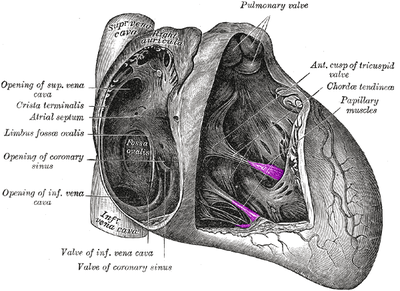
Search
Papillary muscle

The papillary muscles are muscles located in the ventricles of the heart. They attach to the cusps of the atrioventricular valves (also known as the mitral and tricuspid valves) via the chordae tendineae and contract to prevent inversion or prolapse of these valves on systole (or ventricular contraction).
Structure
There are five total papillary muscles in the heart; three in the right ventricle and two in the left. The anterior, posterior, and septal papillary muscles of the right ventricle each attach via chordae tendineae to the tricuspid valve. The anterolateral and posteromedial papillary muscles of the left ventricle attach via chordae tendineae to the mitral valve.
Blood supply
The mitral valve papillary muscles in the left ventricle are called the anterolateral and posteromedial muscles.
- Anterolateral muscle blood supply: left anterior descending artery - diagonal branch (LAD) and left circumflex artery - obtuse marginal branch (LCX)
- Posteromedial muscle blood supply: right coronary artery - posterior interventricular artery (RCA)
The posteromedial muscle ruptures more frequently because it only has one source of blood supply, hence RCA occlusion can cause papillary muscle rupture.
Function
The papillary muscles of both the right and left ventricles begin to contract shortly before ventricular systole and maintain tension throughout. This prevents regurgitation—backward flow of ventricular blood into the atrial cavities—by bracing the atrioventricular valves against prolapse—being forced back into the atria by the high pressure in the ventricles.
Clinical significance
Papillary muscle rupture can be caused by a myocardial infarction, and dysfunction can be caused by ischemia. Rarely, blunt chest trauma can be the cause of papillary muscle rupture, resulting from the sudden deceleration or compression of the heart. Complications may lead to worsening of mitral regurgitation.
Additional images
See also
- Trabeculae carneae
References
External links
- Anatomy photo:20:19-0106 at the SUNY Downstate Medical Center} — "Heart: The Right Atrioventricular (Tricupsid) Valve" (anterior, posterior, septal papillary muscles)
- Anatomy photo:20:26-0105 at the SUNY Downstate Medical Center — "Heart: The Left Atrioventricular (Mitral) Valve" (anterior, posterior papillary muscles)
- Atlas image: ht_rt_vent at the University of Michigan Health System} — "Right atrioventricular bundle branch, anterior view"
- Definition of Papillary muscle
- MedicineNet Search Results
Text submitted to CC-BY-SA license. Source: Papillary muscle by Wikipedia (Historical)
Articles connexes
- Coronary circulation
- Moderator band
- Chordae tendineae
- Mitral valve
- Myocardial rupture
- Mitral regurgitation
- Heart
- Heart sounds
- Left anterior descending artery
- Trabeculae carneae
- Coronary arteries
- Circumflex branch of left coronary artery
- Papilla
- Heart valve
- Parachute mitral valve
- Papillary thyroid cancer
- Tricuspid valve
- Cardiac conduction system
- Bundle of His
- Purkinje fibers
Owlapps.net - since 2012 - Les chouettes applications du hibou



